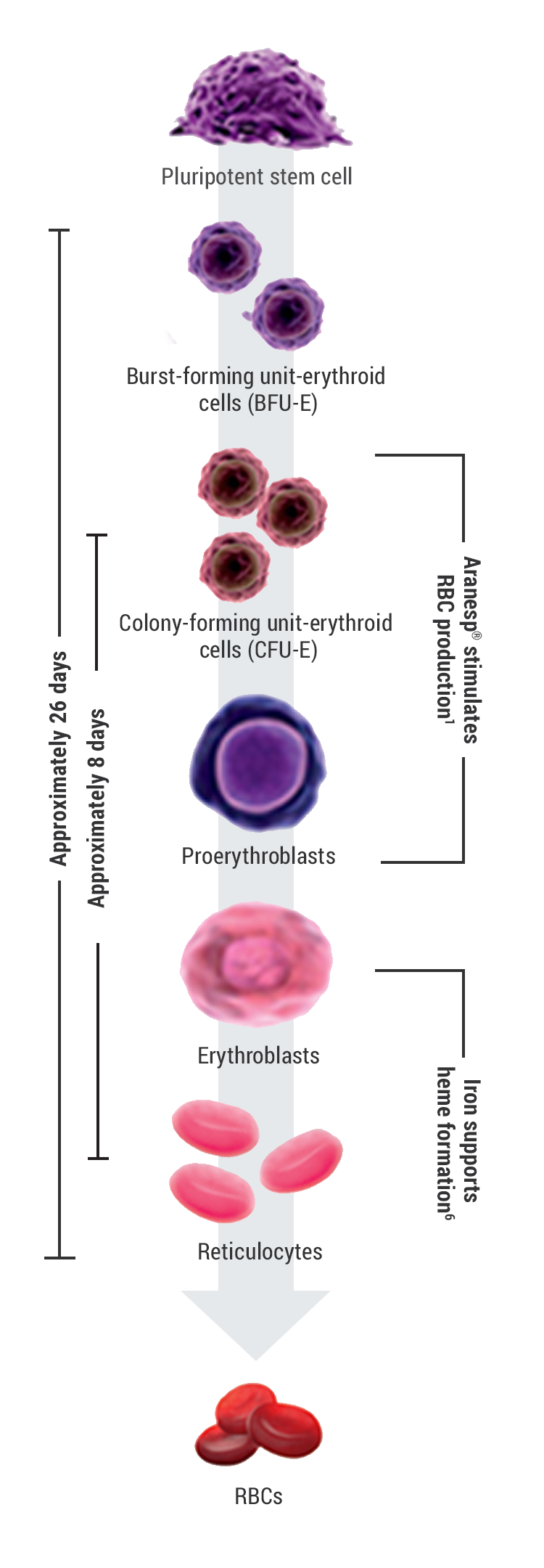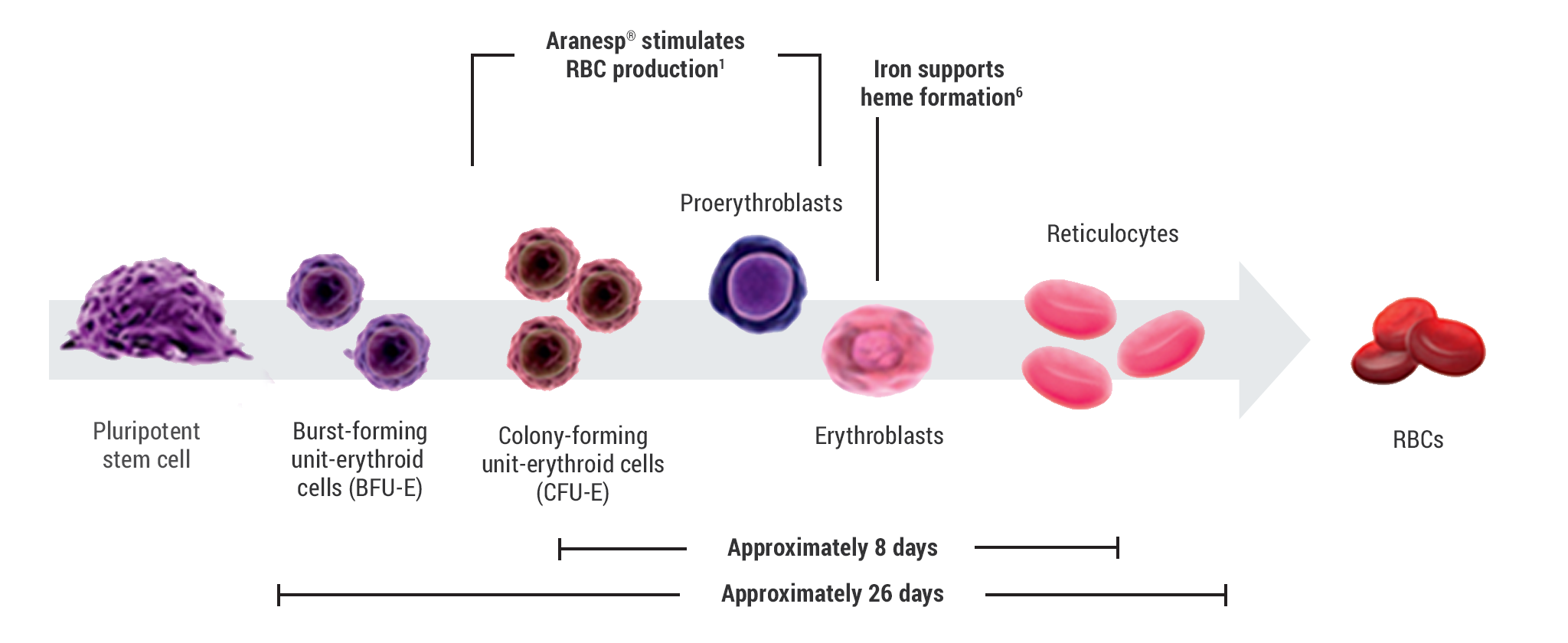Important Safety Information WARNING: ESAs INCREASE THE RISK OF DEATH, MYOCARDIAL INFARCTION, STROKE, VENOUS THROMBOEMBOLISM, THROMBOSIS OF VASCULAR ACCESS AND TUMOR PROGRESSION OR RECURRENCE Chronic Kidney Disease:
● In controlled trials, patients experienced greater risks for death, serious adverse cardiovascular reactions, and stroke when administered erythropoiesis-stimulating agents (ESAs) to target a hemoglobin level of greater than 11 g/dL.
● No trial has identified a hemoglobin target level, Aranesp® dose, or dosing strategy that does not increase these risks.
● Use the lowest Aranesp® dose sufficient to reduce the need for red blood cell (RBC) transfusions.
Cancer:
ESAs shortened overall survival and/or increased the risk of tumor progression or recurrence in clinical studies of patients with breast, non-small cell lung, head and neck, lymphoid, and cervical cancers.
To decrease these risks, as well as the risk of serious cardiovascular and thromboembolic reactions, use the lowest dose needed to avoid RBC transfusions.
Use ESAs only for anemia from myelosuppressive chemotherapy.
ESAs are not indicated for patients receiving myelosuppressive chemotherapy when the anticipated outcome is cure.
Discontinue following the completion of a chemotherapy course.
Important Safety Information
WARNING: ESAs INCREASE THE RISK OF DEATH, MYOCARDIAL INFARCTION, STROKE, VENOUS THROMBOEMBOLISM, THROMBOSIS OF VASCULAR ACCESS AND TUMOR PROGRESSION OR RECURRENCE
Chronic Kidney Disease:
- In controlled trials, patients experienced greater risks for death, serious adverse cardiovascular reactions, and stroke when administered erythropoiesis-stimulating agents (ESAs) to target a hemoglobin level of greater than 11 g/dL.
- No trial has identified a hemoglobin target level, Aranesp® dose, or dosing strategy that does not increase these risks.
- Use the lowest Aranesp® dose sufficient to reduce the need for red blood cell (RBC) transfusions.
Cancer:
- ESAs shortened overall survival and/or increased the risk of tumor progression or recurrence in clinical studies of patients with breast, non-small cell lung, head and neck, lymphoid, and cervical cancers.
- To decrease these risks, as well as the risk of serious cardiovascular and thromboembolic reactions, use the lowest dose needed to avoid RBC transfusions.
- Use ESAs only for anemia from myelosuppressive chemotherapy.
- ESAs are not indicated for patients receiving myelosuppressive chemotherapy when the anticipated outcome is cure.
- Discontinue following the completion of a chemotherapy course.
- Aranesp® is contraindicated in patients with:
- Uncontrolled hypertension
- Pure red cell aplasia (PRCA) that begins after treatment with Aranesp® or other erythropoietin protein drugs
- Serious allergic reactions to Aranesp®
- In controlled clinical trials of patients with cancer, Aranesp® and other ESAs increased the risks for death and serious adverse cardiovascular reactions. These adverse reactions included myocardial infarction and stroke.
- In controlled clinical trials, ESAs increased the risk of death in patients undergoing coronary artery bypass graft surgery (CABG) and the risk of deep venous thrombosis (DVT) in patients undergoing orthopedic procedures.
- Control hypertension prior to initiating and during treatment with Aranesp®.
- For lack or loss of hemoglobin response to Aranesp®, initiate a search for causative factors. If typical causes of lack or loss of hemoglobin response are excluded, evaluate for PRCA.
- Cases of PRCA and of severe anemia, with or without other cytopenias that arise following the development of neutralizing antibodies to erythropoietin have been reported in patients treated with Aranesp®.
- This has been reported predominantly in patients with CKD receiving ESAs by subcutaneous administration.
- PRCA has also been reported in patients receiving ESAs for anemia related to hepatitis C treatment (an indication for which Aranesp® is not approved).
- If severe anemia and low reticulocyte count develop during treatment with Aranesp®, withhold Aranesp® and evaluate patients for neutralizing antibodies to erythropoietin.
- Permanently discontinue Aranesp® in patients who develop PRCA following treatment with Aranesp® or other erythropoietin protein drugs. Do not switch patients to other ESAs.
- Serious allergic reactions, including anaphylactic reactions, angioedema, bronchospasm, skin rash, and urticaria may occur with Aranesp®. Immediately and permanently discontinue Aranesp® if a serious allergic reaction occurs.
- Blistering and skin exfoliation reactions including Erythema multiforme and Stevens-Johnson Syndrome (SJS)/Toxic Epidermal Necrolysis (TEN), have been reported in patients treated with ESAs (including Aranesp®) in the postmarketing setting. Discontinue Aranesp® therapy immediately if a severe cutaneous reaction, such as SJS/TEN, is suspected.
- Adverse reactions (≥ 1%) in Aranesp® clinical studies in cancer patients receiving chemotherapy were abdominal pain, edema, and thrombovascular events.
Indication
Aranesp® is indicated for the treatment of anemia in patients with non-myeloid malignancies where anemia is due to the effect of concomitant myelosuppressive chemotherapy, and upon initiation, there is a minimum of two additional months of planned chemotherapy.
Limitations of Use:
Aranesp® has not been shown to improve quality of life, fatigue, or patient well-being.
Aranesp® is not indicated for use:
- In patients with cancer receiving hormonal agents, biologic products, or radiotherapy, unless also receiving concomitant myelosuppressive chemotherapy.
- In patients with cancer receiving myelosuppressive chemotherapy when the anticipated outcome is cure.
- In patients with cancer receiving myelosuppressive chemotherapy in whom the anemia can be managed by transfusion.
- As a substitute for RBC transfusions in patients who require immediate correction of anemia.
Please see Aranesp® full Prescribing Information, including Boxed WARNINGS, and
Medication Guide.


